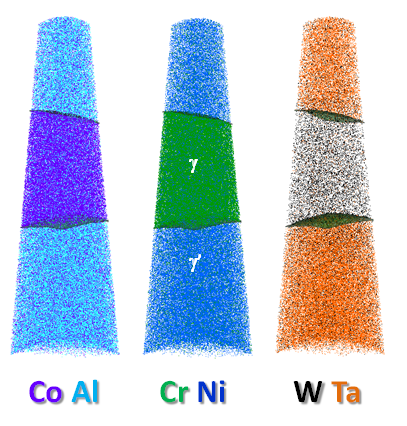I am a professional scientist, editor and science fiction writer. I am currently Associate Professor in Materials Physics at the University of Bristol's School of Physics. My work centres on atomic and nano-scale characterisation of materials for energy, including nuclear reactors, aircraft engines and photovoltaic panels. In particular, I specialise in the use of atom probe tomography, a technique where individual atoms are evaporated from a needle of material into a time-of-flight detector, which gives both elemental and positional information. Over the course of hours and millions of atoms, a 3D atom-by-atom reconstruction of the material can be undertaken.
We use this technique to look at many fascinating material systems, including nickel, titanium and cobalt alloys for use in plane engines and bodies, components from nuclear fission and fusion reactors, silicon, diamond and gallium nitride semiconductors, as well as more exotic items such as fossils, calcified heart tissue and meteorites.
Studying as a physicist
I studied Physics with Astrophysics at the University of Bristol as an undergraduate, including working on a simulation of the Higgs Boson at the LHC for my masters project.
Following completion of my masters I began a PhD, where for over three years I was a researcher in semiconductor physics at the University of Bristol. My project involved researching doped artificial diamond for use in solar power thermionic devices. Our goal was to generate electricity from the sun's warmth using nanodiamonds!
Industrial work as a consultant on renewable energy projects
Following completion of my PhD I spent two years working as a consultant engineer for the engineering firm Wind Prospect. My team in Advisory Services performed due diligence and feasibility studies for banks and investors looking to fund or purchase wind farms and solar power plants.
Cotton Farm, one of the wind farms I advised on during my time as a consultant engineer.
During my time at the company I advised on over 3000MW of wind farms around the world, including in the UK, Poland, Ireland, South Africa, Kazakhstan and France. Some of these wind farms were operational, whilst others were in development or even under construction. I also worked on a number of solar projects in the UK, Guadeloupe and Australia.
Returning to academia as a material science postdoc
After two years working in industry, I decided in 2013 to return to academia. I took a post as postdoctoral lab manager in the Department of Materials at the University of Oxford. As part of my work at Oxford I maintained the two atom probe instruments in the atom probe group, and ran experiments on both instruments for the group's academic and industrial collaborators, as well as installing a new LEAP 5000 atom probe instrument. I worked on a huge range of materials including steel alloys for use in nuclear reactors and gas pipelines, titanium, nickel and cobalt alloys for aeronautical applications, zirconium and uranium alloys for nuclear fuel and diamond, silicon and III-V semiconductor devices.
In July 2014 I also took up a part-time position as Managing Editor of the scientific journal Materials Today Communications. In 2022 I became Editor-in-Chief of the journal.
In January 2017 I returned to the University of Bristol to take up a lecturer position in the Department of Physics. I teach a course on the Nuclear Fuel Cycle for the MSc in Nuclear Science and Engineering, as well as Materials Physics for the undergraduate Physics course. My research at Bristol is based in the Interface Analysis Centre, where I investigate the microstructure and atomic-scale chemistry of materials such as nuclear reactor and aircraft components, semiconductor devices and biomaterials. In 2022 I was promoted to Senior Lecturer in Materials Physics, and was awarded the Amazon Physical Science Fellowship. In 2023 I was promoted to Associate Professor in Materials Physics. From 2022-2024 I am Director of the MSc in Nuclear Science and Engineering at the University of Bristol, which takes around 25 students for a one year programme to train the next generation of nuclear engineers, physicists and materials scientists.
Atom Probe Tomography
Atom probe tomography is a relatively new field of material science, and to date there are only around a hundred atom probe instruments worldwide, and only two locations in the UK, with three instruments at the APT laboratory at the University of Oxford that I ran for four years.
The Local Electrode Atom Probe (LEAP) that I manage at the University of Oxford.
Atom probe tomography is based upon the controlled evaporation of individual ions from a very sharp needle-shaped specimen, projecting them onto a position-sensitive time-of flight detector. From the resulting data, a three-dimensional atomistic reconstruction of the tip, incorporating millions of these ions, is computer generated with highly accurate spatial resolution and elemental composition. Until recently atom probe has been limited to the analysis of highly conductive samples. However, recent instrument advances and in particular the advent of the laser-assisted local electrode atom probe (LEAP) has opened the technique up to the study of semiconductors and even insulating materials such as diamond, which previously would not have been possible to study.
A sample set of atomic maps from a nickel superalloy for use in aeroplane engines. Each colour corresponds to a different element detected with the needle-shaped specimen. The presence of two different phases are clearly seen in this alloy - the presence of both is required for the alloy to perform well in the high stress, high temperature environment of a plane engine.
Academic publications
For the scientifically curious amongst you, links to my academic publications can be found on my Scientific Publications page.



